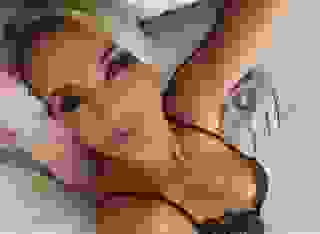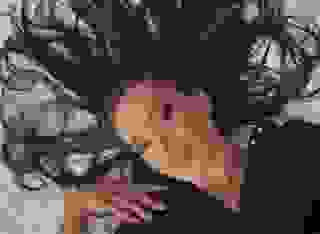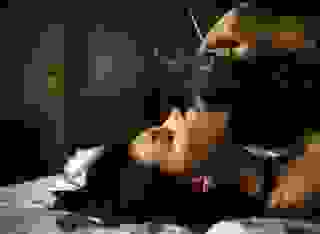- Sci-Fi & Fantasy
- Gabatrix: The Shira Maneuver
Note: You can change font size, font face, and turn on dark mode by clicking the "A" icon tab in the Story Info Box.
You can temporarily switch back to a Classic Literotica® experience during our ongoing public Beta testing. Please consider leaving feedback on issues you experience or suggest improvements.
Click hereDisclaimers
Tags: Swearing, Space, Science Fiction, Future, Sex, Love, War, Violence, Blood, Interspecies, Male Human, Female Alien, Scalie, Human/Alien Sex, Rough Sex, M/F
Disclaimer 1: This is the seventh story of the Gabatrix series. It is highly recommended that you read the other Gabatrix stories to enjoy the full experience before getting into this story. This story deals with a war between humanity and an alien race and does contain violence.
Disclaimer 2: This story is meant for adults as it contains sex, violence, cursing, and blood.
Special Thanks to my Patreon supporters:
Jordy, Mike Nixon, Frank Nordhaus, Quintin Martin, Nightsound, and Anthony Kestle for their generous donations
And, of course, the other patron supporters for allowing me to write and supporting the universe that I write. :)
By CMed
Prologue
"There are many iterations of a perfect plan. One requires the utmost patience. The most successful of plans are ones that take the longest to implement and they warrant the largest amount of variables as the action is made." Shira, 2347 AD.
....... Humanity and the Itrean clan known as the T'rintar share a steady alliance. It tries to hold strong despite the attempts to undermine it from within.......
.......Piracy and the other Itrean clans have not ended their struggle to win a long-going conflict. Threats can be anywhere and arrive at any time.......
.......Each colony stands at the ready. Sometimes the smallest of threats pose the greatest dangers to any ship captain or crew that travel through the void of space.......
Chapter 1: The Fading Light
We stand at the precipice of the black void that is called space. In the distant starlight, we see a single yellow dwarf star glowing that provides a great radiance to a single small habitable planet in the solar system. On it is a shade of green, blue, white, and yellow. It is a sign that there is life in this world. A single moon orbits it as you can only see the very faint signs of distant worlds that orbit around the star itself. We hear nothing and only feel the cold emptiness that space is. Instead, we simply gaze upon the planet. Only the distant stars provide any signs of illumination besides the star closest to here.
It is often said that Earth is a lonely planet in the cosmos. A fascinating concept is that this world was a latecomer in the development of life. While the......supposed name of "The Milky Way Galaxy" is about 13 billion years old, the star that is called "Sol" is one that is actually only about four and a half billion years in age. This may sound like it is a lot. A million years is a flickering span of time. It is actually believed that the planets Venus and Mars were actually some of the first planets to harbor life as Earth was still struggling to develop. If this were true, then the Sol system was a place where three habitable worlds all coincided with one another. Two billion years ago, we would look at Venus to see a planet that slowly spins in reverse from Earth with a beautiful shade of blue, white, orange, and possibly green. Mars would have been a small planet with more landmass but still carrying sizeable oceans of water.
So what happened? In today's sense, Venus is a runaway greenhouse effect. To go there is to be crushed by the immense pressures on the ground. Mars has had its water and atmosphere almost stripped away to leave a red and orange barren rock with only dust storms to show any outside activity. It is apparent that these worlds have the ingredients to have life. A common popular aspect is that Venus might have had early life develop on it but would be slowly cooked by Sol as it expanded in size when it reached mid-age. Earth is expected to eventually turn into Venus sometime in the far future, but that is not in our lifetimes.
Mars might have been another case where life could have developed, but something happened to prevent it. The magnetosphere on Mars is very weak, which means even Sol can slowly rip the atmosphere off of it in time. Technically, Mars' only moons are too small to render much assistance if a moon is needed for life to develop. All is not lost for the tiny planet, however. It is still there, and even to the time period of the 22nd century, it would become the capital of the human race. If a means can be done to stop the runaway greenhouse effect on Venus, even that planet can be fully colonized in time.
Of course, the problem is, however, we are not in the 24th century, and I am not "The Cicerone" that has been giving you the exploration of the cosmos like the past beginning of every story so far.....
......The question is.......who am I? What is that deep, slow methodic female voice that echoes to your ear as you stand floating in the cosmos above the orbit of Earth? You do not know, but it is the only source of comfort that you have as you continue to learn more about the universe around you. It is unknown who the Cicerone is and what their purpose and goal is to accomplish. Instead, you have me to give you the word of the cosmos. It is I that will bring you that information that you haven't had before. Perhaps the guide will one day return to bring his or her's information that will help unravel the universe more and more. For now, you have me to help you along your way.
Instead, we look upon the world that we once called Itrea. It is the world that the humans called "The Land of Dinosaurs" millions of years ago. It was a turbulent time period. Over two hundred million years would pass, and seemingly little happened to occur for developing life. It is the tragic tale for many habitable worlds in the galaxy. Life can develop, but anything with our form of intelligence to randomly evolve is seemingly tiny. So many worlds with potential life.....so few intelligent species that we know of.....so few civilizations.
For a very long time, Earth has been a center point for life to develop, regardless. Even my personal beliefs had been transformed for some time once the human race was discovered. The history of the Itreans has been one that has been considered a great mystery and based on theories. There is much good reason for this. As we stand looking at the world that was once called Itrea, it is much different than that of Earth of today.
That world of what we know as the Mesozoic Era is much different in appearance than Earth is now. The continents known as South America and Africa are nearly touching each other before continental drift would pull them away. North America is split in twain due to flooding waters. Australia and Antarctica are practically together. Europe is nothing but islands that stand between Asia and North America. This was the world that my ancestors supposedly came from. Our people came from all of the continents, and it was a world where you ate the other to survive. The fight for dominance was ordinary and seemingly commonplace.
With that being said, it is obvious why the humans felt that nothing intelligent could have developed during that time period. The skeletons and bones all told the same tale. Bones would show that creatures slashed and cut into one another. Skulls would have tiny sockets for brains when compared to the humans of the 24th century. What made matters worse was that something happened to mark the end of the Mesozoic Era, which would occur with an asteroid that was expected to be almost 80 kilometers long. Itrea had been hit by many asteroids before. The curse of being almost alone was that nobody was going to help you. The benefit is that few giant rocks would come careening into your world either. Unfortunately for the inhabitants, this was when their luck would finally run out.
The humans call this enormous crater the Chicxulub Crater. It is the second-largest asteroid impact to ever strike the planet and would only be surpassed by the Verdefort impact of over two billion years ago. It is the location where Armageddon had come to Itrea. So much death.....the asteroid would leave a crater that spanned over 150 kilometers long. It would be responsible for causing massive disruptions to the climate. In the end, 75% of all life would become extinct. It would mark the end of the era of the age of "Dinosaurs."
We watch as the planet unfolds after such a tragedy. Itrea undergoes its transformation. The asteroid impact shatters the internal crust of the planet. Volcanic eruptions are common, while ocean water is sent all over the globe. A new atmospheric layer of dirt, sulfur, and ash is jettisoned into the air. This massive amount of gases and dirt would block out the thermal radiation of the world so severely that massive cooling on the surface would begin.
To the humans, it would be known as the Paleocene Era. With 75% of wildlife extinct, much of the plants that survived would grow with little hindrance. The continents begin their long trek to what would become more known of what it is today. Surprisingly, we see that Itrea recovered very fast after the asteroid impact. For a time, the temperatures were actually higher than now, with almost double the amount of carbon dioxide. With little wildlife to hinder the plants, flora, and trees, the world began to regrow at an alarming rate. Mammals that were struggling to survive suddenly had a world of their own.
Were the dinosaurs truly gone? Not entirely. Even if three-quarters of the life were wiped out, many of the species that survived on Earth prior to the Orange Muck had qualities similar to dinosaurs. Among the greatest contenders were those of the birds. Sharks, amphibians, insects, and other reptiles survived to continue evolving. The asteroid had been devastating, but it was not the end of Itrea. If anything, it was merely an opportunity for something else to begin.
The real question is, could it had been possible that some of the few non-avian dinosaurs to survive? Evolution is a fickle concept at times. Velociraptors, Oviraptors, Allosaurus.....the humans had long claimed that they all ceased to exist the moment that the asteroid came barreling down upon Itrea. Most likely, all but a few made it in the end, and those who struggled to survive on a planet were undergoing rapid changes.
The only proper way of answering that question is to look for signs of civilization. Were there any signs of past civilizations before humanity? Unfortunately, that is a difficult question to solve. If the human race were to depart from Earth, like most of them have, then within thousands of years, the great buildings would erode and return to nature. Within hundreds of thousands of years, those structures would be gone entirely. Was it possible for the dinosaurs, the sharks, and other life to begin forming an intelligence and civilization?
Unfortunately, seemingly little is there. The past achievements of my people are all but guesswork by the Itreans and Humans of today. We continue to watch Earth as it goes through the Paleocene Era. The continents are moving farther and farther apart from one another. It is fascinating that at one time, almost all of the continents were supposedly together.
What is believed is that sometime after the asteroid impact was that my people either worked with the other surviving growing intelligent sharks and dinosaurs. We had small towns where we harvested the food, developed our own religions, and even had what you called a civilization. Supposedly, it took almost six million years for the human race to become what it is today. The Itreans had plenty of time for 66 million years to finally progress to what it is now before the arrival of humankind. Where those bones of my people are at is a mystery, but perhaps it lies in the great ocean depths waiting to be uncovered.
This leads to the inevitable conclusion of an intelligent growing civilization of any world. What happened to that civilization? It is a theory that I best surmise of my people that the peak of our society was during the Paleocene-Eocene Thermal Maximum. This was a time where Itrea was the hottest at being around an average temperature of 30 degrees Celsius. The asteroid impact still left lingering consequences upon our people. Carbon Dioxide emissions were higher than expected, causing the temperatures to be on par with the era of dinosaurs. Life was starting to adapt to this increased amount of heat and supposedly flourished. However, all good things eventually come to an end. The humans, unfortunately, have no fundamental belief in what caused the Paleocene-Eocene Thermal Maximum to come to an end or what started it. All that my people must have known was that everything was getting colder.
It must have been gradual, but the effects were substantial. It is my firm belief that the Itreans evolved much slower than humans. Even if we did have brains to think like them or beliefs that coincided with them, we operated differently in the end. We were at one with the environment, and we lived as simple people would. We survived until we started to see that our world was getting colder and colder. Desperation leads to innovation. All the civilizations got together and finally lifted up their hands to try to find out why the world was changing. It was here that we created the first rockets that eventually began to traverse orbit. Our technology was still primitive, but we had enough that we were learning about the Sol system.
There is an ancient religion that no longer exists in the Itrean clans. This is known as "Itrea'Nolala'Ko" or "The Slow Armageddon of Itrea" in the human tongue. This belief would span into other religions, but the common belief must have been where the Itreans had learned of the same possible fates of Venus and Mars. These were worlds that once supposedly held life on them, at least to the Itrean beliefs at the time. Itrea was slowly changing, and the Itrean people experienced a traumatic event of an asteroid collision that would decimate trillions in the deep ancient past. To them, the Itreans must have felt that the world of Itrea was doomed to be destroyed or made uninhabitable. More resources were being devoted to the developing civilization to encourage outer space travel and find new places to live before Itrea would experience true Armageddon.
While most of this is still guesswork, there is another aspect in the ancient Itrean history that suggests something interesting. The humans never invented space folding gate travel. They instead reverse engineered it from alien wreckage on Mars in the 23rd century. Was the technology ours? Unfortunately, we don't have that answer. So little information is available.....in the end, we have to go by legends and myths.
It is my belief that the ancient Itreans never really reached Mars or even Luna, for that matter. Their technology was even more basic than the humans. Something fell into our laps, and all of it rests on a single legend......the Kiline.
The Kiline are often looked at as the "The First Ones." This name resides in the Itrean language because they are believed to be the first sentient alien race that we ever encountered. To some of us, they are gods. To some, they are travelers with incredible power. We generally look at them as the guides to the universe. Perhaps even the Cicerone that has been guiding you in the first several stories might actually be one of these Kiline, to begin with. In the end, I have no answer to provide.
Whatever are their true names, the Kiline must have had pity for the Itrean people. They provided something to us that would revolutionize our civilization. It was so important that it would even help the human race as well. The technology was that of gate folding technology. With it, we could open up wormholes and jump to new solar systems. Even if it was the only piece of equipment, the gift of the travelers was one that we would remember in legend, even if others claimed we simply discovered it ourselves.
Whether it is true or not doesn't matter. With the ability to fold space, the Itreans and their ancient belief that their world would come to an end drove the people to space exploration. With gate folding technology, they eventually found new worlds to settle on. The ancient religion of Itrea'Nolala'Ko would help push the many developing clans to abandon the planet. It must have been rough. Unlike the 22nd century "Earth to Mars Exodus," for the Itreans, everyone began to pack up their belongings as they got on the ships. New awaited worlds were available that were far better than Itrea was ever imagined. The Promised Land awaited, and Itrea was to be forgotten. For the ones that possibly stayed on the planet, it is apparent that they never made it.
Instead, we say goodbye to this world. We begin to leave this planet as it would eventually have a new name.....Earth. A new civilization and intelligent race known as humanity would be brought forth as the world would undergo a Great Ice Age to further challenge life on it. To give credit, the humans managed to do well if they were able to survive such low hostile temperatures and still become what it is today. Perhaps they managed to do something that even the Itreans were too fearful of challenging.
Earth shrinks in the background. We get to faster and faster speeds. We move faster than the speed of the light as Sol begins to shrink down to a tiny speck in the galactic background. Just like everything else, the small yellow dwarf star is just a glowing dot in the vast amounts of other bright dots in the blackness of space. If only everyone could experience this form of travel, it would be more desirable than gate folding technology. We would begin to see the sheer size of the galaxy alone. We move at faster and faster speeds as the dots start to move. It is like driving through a three-dimensional light shower. We see the heated gases of star clusters in the center to even see Sol is just part of a massive moving series of star filaments orbiting the galactic center of the Milky Way galaxy.
Our destination is one that brings us through the heart of the Milky Way Galaxy. We pass through a massive yellow and orange light that the distant specks of light began to fade. The surrounding environment is so bright that we can barely see anything......with the exception of those that absorb light. It is here that we see clusters of black holes. Most of them are small but are in synchronized orbit with one another. Eventually, these black holes and pulsars would fly into one another to grow in size. We pass by one that is utterly enormous. Perhaps this is Sagittarius A that is part of the heart of the galactic engine that drives the millions of stars around it.
It is an unusual feeling. To see such bright light replaced with black stars rivals what we see of everything else. If sentient life could develop here, then it must feel that the outside is empty nothingness, devoid of life, and devoid of light.
But our destination is not here as we continue to traverse through the heart of the galaxy. Giant stars began to fly past us that are utterly enormous and make Sol seem like a speck of dirt when placed next to it. Beautiful and bright, these stars burn brighter and hotter, but they will fall like so many things....often with a rather large explosion.
Where did the Itrean civilizations travel and develop? Our answer finally comes closer and closer to us. We watch as our eyes adjust to the new light that comes before us. We leave that vast assortment of light and gases that illuminate the cosmos. We continue to watch stars zip past us at an alarming rate. In the end, we have traversed tens of thousands of light-years. We are essentially on the other side of the Milky Way Galaxy. For the Itreans, the Itrea'Nolala'Ko drove us to get as far away from the planet as possible. It made sense that the opposite of the galaxy was the prime choice.








